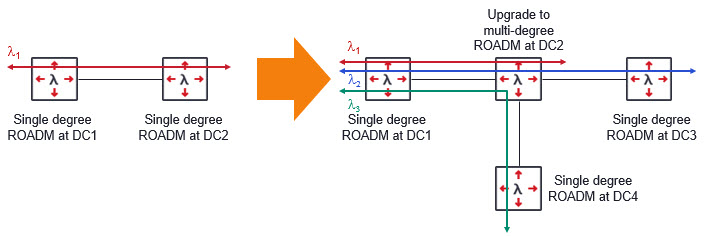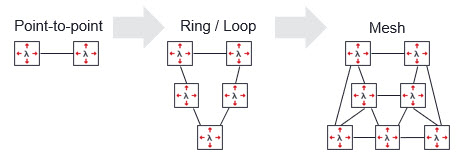Why ROADM architectures make sense for your DCI network
As cloud and content providers race to increase capacity and lower cost, they are also striving to ease deployment and operation of their Data Center Interconnect (DCI) networks . They want to reduce the complexity of the products and network architectures that are being deployed to enable rapid, large-scale deployments. Highly flexible, Reconfigurable Optical Add/Drop Multiplexer (ROADM) architectures can add flexibility to simplify photonic layer operations, but until recently ROADM technology has not generally been considered for metro DCI because large cloud and content providers have prioritized cost-efficiency over flexibility.
For DCI, the photonic layer needs to be as simple, streamlined, and cost-efficient as possible. Today, many DCI networks are built with point-to-point links for simple, low-cost extension of the data center fabric to a second site. These point-to-point DCI networks are built with passive Channel Multiplexer/Demultiplexer (CMD) filters to enable Dense Wavelength Division Multiplexing (DWDM) so that many wavelengths can run across the same fiber.

Simple point-to-point DCI
Does this mean there isn’t a fit for ROADM in metro DCI networks? Far from it. In fact, a developing trend is that DCI network operators are deploying ROADMs for point-to-point DCI to provide greater flexibility and operational simplicity.
Typical point-to-point networks are simple and cost-effective, but they lack flexibility. Since it can be challenging to insert new data centers into an existing point-to-point network, some network operators are turning to ROADM for the flexibility to add new sites whenever, and wherever they want.
Why use ROADM for point-to-point DCI? It’s all about flexibility.
ROADMs make connecting new data centers into the network easier. Many smaller DCI networks start with only two or three physical locations, with plans to add more sites in the future. A network with a pair of data centers plus two on the horizon can initially be deployed as a point-to-point network with single-degree ROADM at each location. Later, when the third and fourth sites are ready to be added, ROADM makes the upgrade simple.
New ROADM degrees can be inserted at the existing sites, as needed, to provide a fiber connection to each of the new locations. The ROADM enables wavelengths to flexibly route between each of the sites, whether they require a point-to-point connection or a cost-effective express wavelength that optically passes through an intermediate site. Later, if even more data centers are added to the network, they can be interconnected in the same way.

Easily add and interconnect new locations using ROADM to extend data center fabric across multiple sites
ROADMs also give the flexibility to change the network’s topology when interconnecting new locations. A simple, point-to-point network with two nodes can be morphed into a loop or ring when more locations are added. Later, the ring can be evolved into a mesh-based network to efficiently interconnect new data centers to any site in the network.

Evolve the network’s topology as new data centers are added
ROADMs offer more than the flexibility to easily add new sites. Modern ROADMs also give network operators the flexibility to specify both the channel width and spacing, instead of being tied to a fixed-grid channel spacing. Flexible grid effectively future-proofs DCI networks, enabling support for new coherent technologies as they are introduced to the market. So, a network being built with 400G or 800G coherent can also support 400ZR and future coherent pluggable interfaces.
Essentially ROADMs give the flexibility to take on network uncertainty. Whether it comes from not knowing the precise location of future data centers when building the network day-one, or it comes from keeping up with changing coherent technology – ROADM gives you the flexibility to easily adapt to new networking requirements.
What about the cost? Making ROADM more cost-effective for metro DCI.
In the past, point-to-point has often won the battle for metro DCI deployments because of the initial cost premium for ROADM hardware. But ROADM networks can be cost-optimized for metro DCI to reduce the initial cost. In networks with lower traffic volume, first-in costs can be reduced by using transponder direct attach, where transponders can be directly attached to available ports on the ROADM card without requiring a CMD. If traffic requirements dramatically increase in the future, a colored or colorless CMD can be connected to the ROADM to increase the number of available add/drop ports.

First-in cost optimized configuration with transponder direct attach
New photonic line systems, like Ciena’s 6500 RLS, integrate multiple features into a single module to maximize density, provide more ports per ROADM blade for direct attach, and simplify sparing by reducing the number of unique part numbers in the network. That means more degrees of connectivity to add more sites plus room for more add/drop ports in a space efficient design. That helps streamline operations while keeping costs down as networks scale.
Staying ahead of customer demand requires more than high-capacity DCI. Network operators also need flexible photonic line systems that can adapt to changing customer demand and easily scale, whether that means the ability to easily insert new sites into the network or flexibly increase add/drop at a site. Ciena’s 6500 RLS is a compact, simple-to-deploy, photonic layer solution that improves scalability, reduces footprint, and offers more flexibility and programmability. It provides highly dense ROADM configurations that have been designed for metro DCI, so you can quickly react to changing connectivity and add/drop requirements, keeping your DCI network ahead of the competition.
With Ciena, your DCI is always flexible. Always ahead.




